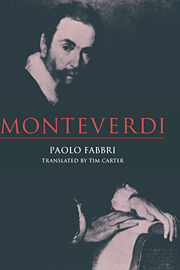II - Mantua
Published online by Cambridge University Press: 05 May 2010
Summary
Mantua
It is clear that by the end of the 1580s, Monteverdi had more than once sought employment outside his native city, first in Verona, then in Milan. In the end, he found it in Mantua, at the Gonzaga court and as a string-player (he had presented himself to Giacomo Ricardi in that same capacity during his visit to Milan). We do not know for sure when Monteverdi began working in Mantua; however, it was after 1 January 1590, the date of the dedication of the Second Book of madrigals, which makes no mention of it. The first notice of his new position is in the dedication to Duke Vincenzo Gonzaga of Monteverdi's Terzo libro de madrigali a cinque voci, dated Mantua, 27 June 1592, where Monteverdi recalls ‘that day, Most Serene Prince, when to my rare good fortune I came to serve Your Highness … with the most noble practice of the viola which opened the fortunate gate of your service’ and notes how ‘my skill flowered for you in playing the viola…’. In years to come, Monteverdi occasionally referred to the length of his stay in Mantua, but without resolving the matter once and for all. In a letter to Annibale Chieppio dated Cremona, 2 December 1608 (L.6), he speaks of ‘nineteen consecutive years’; and some days before, in a petition to Duchess Leonora dated Cremona, 27 November 1608, his father Baldassarre Monteverdi recalled the ‘nineteen years in which he has found himself in the service of the Most Serene Lord Duke of Mantua’ (see p. 100).
- Type
- Chapter
- Information
- Monteverdi , pp. 22 - 125Publisher: Cambridge University PressPrint publication year: 1994



